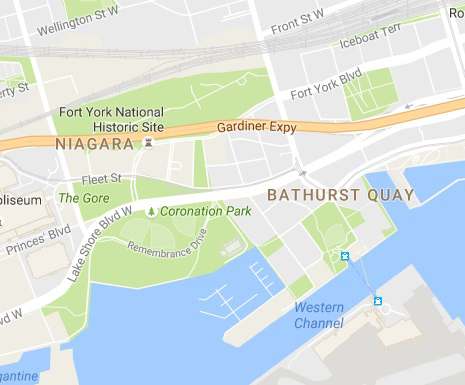This is another meandering blog post… a post about being out and about on yet another wonderful autumn day, going wherever my feet and eyes take me.
below: The first picture of my day was this intriguing wall made of old wooden doors. Bathurst Street.
below: A small elicser mural tucked away at the end of a parking lot. The man has his back to the viewer but I can’t figure out what’s behind him or what he might be doing.
below: The leaves have fallen off the vines to reveal a yellowish creature with his baseball cap askew.
below: Toronto’s tallest icon framed by a construction crane.
below: And on a similar note, a vacant lot cleared and ready for the next stage of its life.
below: No more cranes here (and not many vacant lots either for that matter). A view showing how much development there has been on the south side of the railway tracks. Fort York is between the tracks and the condo towers.
below: And what’s this? An old blue canoe beached on the tracks?
below: Standing guard over Bathurst Street, Fleet street and the Lakeshore, is one larger than life gold replica of a Royal Newfoundland Regiment and his fallen silver American foe. A sculpture by Douglas Copeland entitled “A Monument to the War of 1812”, a nod to nearby Fort York and the history of Toronto.
below: My favorite example of bad grammar still exists! Off-leash dog area at Coronation Park.
A beautiful day in the park. A slight November nip was in the air but it was sunny and the sky was a brilliant shade of blue. Coronation Park is named in honour of the coronation of King George VI who was crowned on 12 May 1937. At that time nearly 150 trees were planted here.
Apparently, an oak tree was planted to honour the king. Surrounding it, a ring of silver maples was planted. This was to symbolize the countries of the British Empire. I wish I had known that bit of trivia before I walked through the park because now I am curious if these trees are still there. Some of the trees are quite substantial.
below: Long shadows for the morning sun, low in the sky.
below: Looking back towards the city center, past the empty docks of the National Yacht Club to the residences on Stadium Road. A small group of people were making a video in the dog park.
below: This Victory Peace Monument was unveiled on 14 November 1995 to commemorate the 50th anniversary of the end of World War 2 and honour those who died in that war. It was designed by John McEwen; the bronze pieces resemble the bow of a ship.
below: On the inside of one of the bronze pieces is a map of eastern Canada and the Atlantic Ocean. Each boat on the map represents a ship or U-boat that was sunk during the war. The Canadian ships are located on the map at “their last known position”. I hadn’t realized that so many ships were lost so close to North America.
Trees were also planted to represent the four divisions of the Canadian Expeditionary Force (WW1) and its units as well as those who fought in the Fenian Raids of 1866-1870, the Northwest Rebellion of 1885, and the Boer War (1899-1902). Once upon a time, brass plaques were placed at the foot of each tree to indicate the units the tree stood for. If any plaques remain, I didn’t see them.
below: Another memorial is close by, a “Memorial to Lieut. Tommy Hobbs gallant British Canadian soldier in the Great War 1914 – 1918. Died on active service November 10, 1940. Beloved and remembered by his comrades.” Tommy Hobbs was involved in the creation of this park.
below: A little farther on I noticed another rock, one that was painted red. The bronze plaque on the rock says that 20 trees have been planted here in commemoration of the G20 Summit held in Toronto in 2010.
below: A 30 foot tall Inukshuk stands looking out over Lake Ontario. Approximately 50 tonnes of mountain rose granite was used to create the Inukshuk, which was made by Inuit artist Kellypalik Qimirpik from Cape Dorset, Nunavut.
below: Streetcars across the baseball outfield.
below: A closer look at that brown octagonal structure in the middle of the streetcar loop for the 509 and 511 cars. Apparently it’s the Queens Wharf lighthouse, one of a pair built in 1861.
The lighthouses marked the entrance to the Toronto Harbour from 1861 until the Western Channel was built in the early 1900’s. This one stood on Queen’s Wharf which used to be at the foot of Bathurst Street, adjoining Fort York. The wharf was built by the military; in 1833 it was a pier 42 feet long. The pier no longer exists; a hundred years ago it was buried under what is now Bathurst Quay.
below: A picture of an historical map (1886 or 1887) of the area showing Toronto Harbour, Fort York and the railway lands. Queen’s Wharf is the pier on the left. At that time, Front Street was the southern most street in this part of the city. All the present day development south of the train tracks is on reclaimed land.
below: Taken from google maps, what the layout of the city looks like now. As you can see, there have been many changes!
























